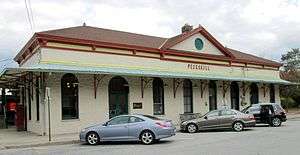Peekskill station
Peekskill | |||||||||||||||||||||||||||||||
|---|---|---|---|---|---|---|---|---|---|---|---|---|---|---|---|---|---|---|---|---|---|---|---|---|---|---|---|---|---|---|---|
 Station and overpass, 2014 | |||||||||||||||||||||||||||||||
| Location |
300 Railroad Avenue Peekskill, New York, 10566 | ||||||||||||||||||||||||||||||
| Coordinates | 41°17′06″N 73°55′51″W / 41.28500°N 73.93083°WCoordinates: 41°17′06″N 73°55′51″W / 41.28500°N 73.93083°W | ||||||||||||||||||||||||||||||
| Line(s) |
Empire Corridor | ||||||||||||||||||||||||||||||
| Platforms |
1 side platform 1 island platform | ||||||||||||||||||||||||||||||
| Tracks | 4 | ||||||||||||||||||||||||||||||
| Connections |
| ||||||||||||||||||||||||||||||
| Construction | |||||||||||||||||||||||||||||||
| Parking | 488 spaces | ||||||||||||||||||||||||||||||
| Disabled access | Yes | ||||||||||||||||||||||||||||||
| Other information | |||||||||||||||||||||||||||||||
| Fare zone | 6 | ||||||||||||||||||||||||||||||
| History | |||||||||||||||||||||||||||||||
| Opened | 1874 | ||||||||||||||||||||||||||||||
| Services | |||||||||||||||||||||||||||||||
| |||||||||||||||||||||||||||||||
The Peekskill Metro-North Railroad station serves residents of Peekskill, New York via the Hudson Line. Trains leave for New York City every hour on weekdays and about every 25 minutes during rush hour. It is 41.2 miles (66.3 km) from Grand Central Terminal and travel time to Grand Central is approximately one hour.[1] It is the northernmost station on the line in Westchester County.
It is just south of a grade crossing whose gates remain down as long as any northbound train is in the station. The former station building built by the New York Central and Hudson River Railroad in 1874[2] still stands, although it is no longer staffed.[3]
History


Rail service in Peekskill can be traced as far back as 1850 to the Hudson River Railroad. The freight depot, was the site of a February 19, 1861 visit by Abraham Lincoln who stopped there during his train trip to his inauguration. The railroad was acquired by the New York Central and Hudson River Railroad in November 1869, and they rebuilt the passenger station in 1874. NYC&HR rebuilt the freight depot around 1890 and today it is on the National Register of Historic Places, as is the Standard House which served the railroad, as well as ships on the Hudson River.
A 1943 New York Central schedule lists Peekskill as the northern terminus of its Hudson Division commuter service. Trains continuing north of Peekskill were "long distance" trains, continuing not just to Poughkeepsie but also to Albany and other destinations.
With the railroads in decline during the post-WW II era, New York Central merged with their long time rival Pennsylvania Railroad in 1968 and the station became a Penn Central station. Amtrak took over intercity passenger service in 1971, but Peekskill station continued to serve only the expanded Penn Central Hudson Division trains which by that time ran to Poughkeepsie and were subsidized by the MTA. Conrail took over Penn Central in 1976 and ran Hudson Branch trains as far north as Albany until 1981 when they reverted to Poughkeepsie where it has remained ever since. MTA assigned the station to the newly established Metro-North Commuter Railroad in 1983.
Station layout
The station has four tracks and two high-level platforms each six cars long. Tracks 4 and 6 terminate at the north end of the station while tracks 1 and 2 continue on.
| M | Mezzanine | Transfer between platforms |
| P Platform level |
Track 6 | No regular service |
| Track 4 | No regular service | |
| Island platform, doors will open on the left | ||
| Track 2 | ← Hudson Line toward Grand Central (Cortlandt) ← Empire Corridor trains do not stop here | |
| Track 1 | Empire Corridor trains do not stop here → Hudson Line toward Poughkeepsie (Manitou or Garrison) → | |
| Side platform, doors will open on the right | ||
| Street level | Exit/entrance, station house, and parking | |
References
- ↑ "MNR Stations - Peekskill". New York, New York: Metropolitan Transportation Authority. 2011. Retrieved April 12, 2011.
- ↑ Butcher, Faith Ann (July 9, 2011). "Ossining, Peekskill Historic Railroad Buildings Available to Rent". The Examiner News. Archived from the original on August 12, 2011. Retrieved July 9, 2011.
- ↑ Google Street View; Peekskill New York Central & Hudson River Railroad Depot
External links
| Wikimedia Commons has media related to Peekskill (Metro-North station). |